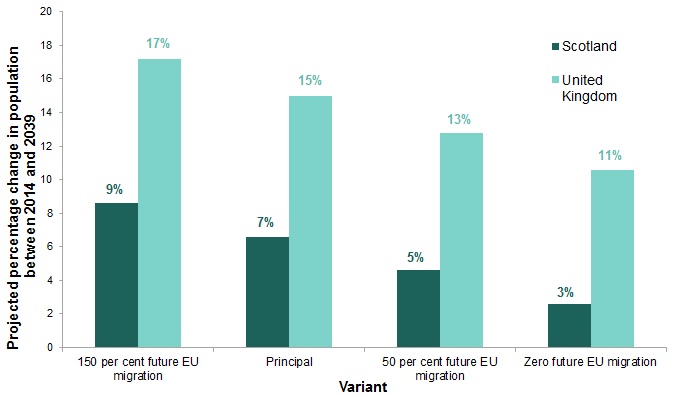Projected Population of Scotland: Additional variants using alternative European Union migration assumptions
Projected Population of Scotland: Additional variants using alternative European Union migration assumptions

National Records of Scotland have today published additional population projections for Scotland based on varying potential levels of European Union migration.
The three additional variant projections do not have National Statistics status and have been created for illustrative purposes only. The additional variant projections are: zero future European Union migration; 50 per cent future European Union migration (50 per cent less future European Union migration); and 150 per cent future European Union migration (50 per cent more future European Union migration). Each of these variants has been produced for both Scotland and the United Kingdom as a whole (including Scotland).
As migration is concentrated amongst young adult ages, the effect of varying the level of migration is greater on the number of children and people of working age than on the number of people of pension age.
The principal projection is the main projection, and if current trends continue it suggests that the population of Scotland may rise from 5.35 million in 2014 to 5.7 million in 2039 – an increase of seven per cent over the 25 year period, as shown in the Figure below.
In the zero future European Union migration variant, the population of Scotland is projected to rise to 5.49 million in 2039 – an increase of three per cent from 2014. However under this variant, the population is projected to peak at 5.50 million in 2033 and then decline gradually after that point.
For the 50 per cent future European Union migration variant, the population of Scotland is projected to rise to 5.59 million in 2039 – an increase of five per cent from 2014. And for the 150 per cent future European Union migration variant, there is a nine per cent rise in population projected, to 5.81 million in 2039.
Figure: Percentage change in population from 2014 to 2039, principal and alternative European Union migration variant projections, United Kingdom and Scotland

Compared to Scotland, the United Kingdom’s projected population increase is more rapid, as shown in the Figure. The principal projection for the United Kingdom suggests that the population may rise from 64.6 million in 2014 to 74.3 million in 2039, an increase of 15 per cent. The more rapid increase projected for the United Kingdom also occurs for each of the additional variants, with an 11 per cent projected increase in population for the zero future European Union migration variant, a 13 per cent increase for the 50 per cent future European Union migration variant and a 17 per cent increase for the 150 per cent future European Union migration variant.
These additional variant projections, using alternative European Union migration assumptions, have been created for illustrative purposes only. Unlike the National Population Projections published by the Office for National Statistics (ONS) on 29 October 2015 and 26 November 2015, these variant projections do not have National Statistics status. This is because the method for creating these additional migration assumptions was not subject to the same rigorous quality assurance and assessment process. National Statistics are assessed by the United Kingdom Statistics Authority as meeting the requirements of the Code of Practice for Official Statistics.
The principal projection was published in October 2015 and the full publication is available in the Population Projections Scotland section of this website.
The full publication Projected Population of Scotland (2014-based): Additional Variants Using Alternative European Union Migration Assumptions is available on this website.